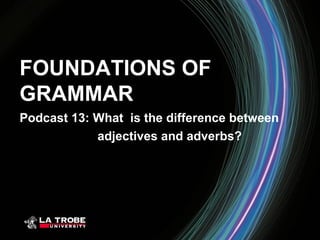
Foundations of Grammar 13: What is the difference between adjectives and adverbs?
- 1. FOUNDATIONS OF GRAMMAR Podcast 13: What is the difference between adjectives and adverbs?
- 2. What is the difference between adjectives and adverbs? Adjectives are words which describe nouns and pronouns to make the meanings of sentences clearer or more exact. Adverbs are words which describe verbs, adjectives, and other adverbs. CLUE: You can therefore tell whether a word is an adjective or adverb by looking at the word it modifies. This is very important in languages whose adverbs are invariable but whose adjectives need to agree in gender and number with the nouns/pronouns they modify.
- 3. Adjectives with nouns He likes classical music. (The adjective “classical” describes the noun “music”) They had an excellent idea. (The adjective “excellent” describes the noun “idea”) Both of them are good students. (The adjective “good” describes the noun “students”)
- 4. Adjectives with pronouns She is very intelligent. (The adjective “intelligent” describes the pronoun “she”) That’s wrong. (The adjective “wrong” describes the pronoun “that”) They are old. (The adjective “old” describe the pronoun “they”)
- 5. Adjectives In many cases we may use more than one adjective in a sentence to describe one or more nouns. E.g.: She wrote an impressive essay on national identity. (The adjective “impressive” describes the noun essay and the adjective “national” describes the noun identity). The room was small but clean and tidy. (In this sentence three adjectives: “small”, “clean”, “tidy” describe the noun “room”.
- 6. Adverbs with verbs He sang softly. (The adverb “softly” describes the verb “sang”) They live together. (The adverb “together” describes the verb “live”) They moved slowly towards the exit. (The adverb “slowly” describes the verb “moved”)
- 7. Adverbs with adjectives She is very intelligent. (The adverb “very” describes the adjective “intelligent”) You are quite right. (The adverb “quite” describes the adjective “right” The students were extremely happy with their results. (The adverb “extremely” describe the adjective “happy”)
- 8. Adverbs with adverbs That student nearly always comes to his class late. (The adverb “nearly” describes the adverb “always”) Your argument is really rather simple. (The adverb “really” describes the adverb “rather”) He has to leave very soon. (The adverb “very” describes the adverb “soon”)
- 9. What is the difference between adjectives and adverbs? Be vigilant: in English, adjectives and adverbs are increasingly used incorrectly. E.g.: He drove real fast. In this example, “real” functions as an adverb (describing the adjective “fast”) and should therefore be “really”. He drove really fast. She speaks really slow. In this example, “slow” functions as an adverb (describing the verb “speak”) and should therefore be “slowly”. She speaks really slowly.
- 10. Thank You Example presentation title Page 10
Notas del editor
- Example title for notes and handouts 19 December 2012 Example footer for notes and handouts This is the Presentation Title page. Type over the existing content to add your title and subtitle. This page uses the slide master for the Heading page. It is recommended that you always include the date of your presentation in the subtitle.
- Example title for notes and handouts 19 December 2012 Example footer for notes and handouts This slide uses the Title and text slide layout. Add a title by clicking on the title box Add information into the bulleted list area by typing the text, and pressing RETURN to create new bullets. The look of the bullets and the text is defined by the design template. To indent your bullet points press the <tab> key. To change the footer information Select View / Header and Footer and change the “Example presentation title” information.
- Example title for notes and handouts 19 December 2012 Example footer for notes and handouts This slide uses the Title and text slide layout. Add a title by clicking on the title box Add information into the bulleted list area by typing the text, and pressing RETURN to create new bullets. The look of the bullets and the text is defined by the design template. To indent your bullet points press the <tab> key. To change the footer information Select View / Header and Footer and change the “Example presentation title” information.
- Example title for notes and handouts 19 December 2012 Example footer for notes and handouts This is the “back slide” in your presentation to show that you have completed your presentation.
